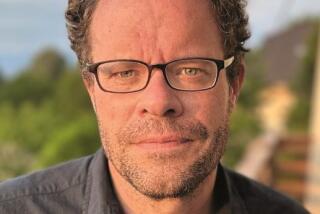The Heart of Hearing : WHAT’S THAT PIG OUTDOORS?; A Memoir of Deafness <i> By Henry Kisor foreword by Walker Percy (Hill & Wang: $18.95; 270 pp.) </i>
- Share via
Henry Kisor, whose story this is, is stone deaf and has been so since an illness at age 3. Now in his 50s, he is a working journalist at the height of his profession, book editor of the Chicago Sun-Times, husband (of a hearing woman), and father of college-age sons. Between the illness of the child and the success of the man lies the story, a lifelong struggle against what Dr. Johnson rightly called “the most desperate of human calamities.”
When asked whether they would, if they had to, choose blindness or deafness, most people choose deafness. And this is because living always in the dark strikes us as unimaginably horrible. But, in truth, anyone who has successively experienced the deprivations of sight and hearing has no trouble making the right choice: blindness. For blindness, though it cuts us off from the visible world, does not cut us off from communication--from humankind--as no one who has read Carson McCuller’s “The Heart Is a Lonely Hunter” can ever forget.
To overcome the permanent, radical loneliness of the deaf requires both enormous will power and great good luck. And even with both these commodities in abundant supply, the most routine matter can bring defeat. The title, “What’s That Pig Outdoors?” is Kisor’s way of reminding the hearing world that even the simplest question, posed by the smallest child, can be misunderstood by a lip-reading deaf man. (The child actually asked about a “big loud noise.”)
Kisor’s pride in his parents, especially his mother, becomes the reader’s pride--it’s nice just to belong to the same species as such people. They never gave up, and their assumption that their son would succeed became his assumption--as taken for granted as the air they breathed. The parents followed the program of an unorthodox teacher, Doris Irene Mirrielees, who believed in teaching the child first to read, then to practice lip-reading and sound-making.
At age 4 (when most deaf children are learning only the most rudimentary language), Henry became a fluent reader--and a more reluctant practitioner of the sounds he could not hear. “Mother had to be my jailer as well as teacher. Four- and five-year-olds have the attention spans of shrews; ten minutes after beginning a two-hour session, I’d demand to be let out to play with my friends. . . . Some days degenerated into a two-hour contest of wills. I was adamant, but Mother was immovable. Until every last lesson of the day had been learned, she wouldn’t release me from battleground to playground.”
Kisor became, thanks to his parents’ unsentimental love and his own intelligence, a part of the hearing world. But this development was forged despite a gaggle of self-appointed busybodies (who were scandalized that a deaf child was allowed out unescorted) and recognized experts (who thought Henry needed therapy because he was “tense” and “hostile” after six hours of tests or--later on, in his teens--because he exhibited a propensity for “adolescent sexual fantasy”).
When Kisor chose journalism, the experts thought he was delusional. And yet, it is hard, reading this book today, to imagine Kisor ever having become anything but a journalist. It is not merely that he writes well: It is that the sculpted clarity of each sentence gives such pleasure. No one could ever misunderstand this writer.
More to Read
Sign up for our Book Club newsletter
Get the latest news, events and more from the Los Angeles Times Book Club, and help us get L.A. reading and talking.
You may occasionally receive promotional content from the Los Angeles Times.









